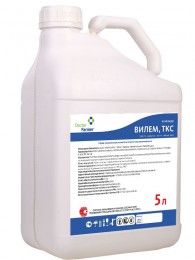
This chemical product is at the registration stage
| Eligible crops: | Cereal crops, Sunflower, Corn, Colza, Leguminous crops |
| Application: | Protectants |
| Harmful sites: | Complex of airborne infections |
| Active materials: | mazalil + tebuconazole |
| Concentration: | 100+60 g/l |
| Chemical family: | imidazoles + triazoles |
| Formulation: | flowable suspension concentrate, FSC |
| Packing: | canister 5 l |
|
|
Culture |
Harmful object |
|
|
|
0,3-0,4 |
Winter wheat
|
Loose smut, firm smut, fusarium root rot, helminthosporium root rot, rhizoctonia root rot, powdery mildew, seed molding |
Pre-sowing treatment of seeds in advance or immediately before sowing. Working fluid consumption - 10 l/t |
-(1) |
|
0,4 |
Fusarium snow mold (in areas of moderately depressed disease development) |
|||
|
0,3-0,4 |
Spring wheat, spelt
|
Loose smut, firm smut, fusarium root rot, helminthosporium root rot, powdery mildew, seed mold |
||
|
Spring barley, winter barley
|
Loose smut, stone smut, fusarium root rot, helminthosporium root rot, seed mold, net spot |
|||
|
Winter rye
|
Stem smut, helminthosporium root rot, fusarium root rot, leaf rust, powdery mildew, seed molding |
|||
|
0,4 |
Fusarium snow mold |
|||
|
0,3-0,4 |
Oats
|
Hard (coated) and dusty smut, fusariumand helminthosporium root rot, seed molding, red-brown spotting |
||
|
0,4
|
Corn for grain,
oil
|
Bladder smut, loose smut, fusarium rootand root rot, fusarium, molding of seeds and cobs |
Pre-sowing treatment of seeds in advance or immediately before sowing. Working fluid consumption – 5-10 l/t |
|
|
Sunflower
|
Phomopsis, white rot (root form), gray rot (seed infection), fusarium root rot, seed mold |
Pre-sowing treatment of seeds in advance or immediately before sowing. Working fluid consumption – 10 l/t |
||
|
Spring and winter rape |
Root rot, downy mildew, seed mold, Alternaria blight | |||
|
Soybeans
|
Fusarium root rot, ascochyta blight, fusarium blight, seed molding |
Pre-sowing treatment of seeds in advance or immediately before sowing. Working fluid consumption – 5-6 l/t |
||
|
0,3-0,4 |
Peas, chickpeas |
Fusarium root rot, Fusarium wilt, ascochyta blight, seed molding |
Pre-sowing treatment of seeds in advance or immediately before sowing. Working fluid consumption – 10 l/t |
|
|
Millet
|
panicle smut |
Pre-sowing treatment of seeds in advance or immediately before sowing. Working fluid consumption - 10 l/t |
Advantages
Mechanism of action
We will contact you shortly.